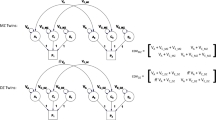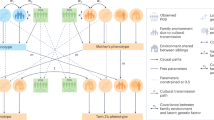Abstract
The frequency of twinning among women who have already borne twins, the ‘repeat frequency’, is significantly higher than in the general population1–6. Individual propensity is not necessarily genetic in origin, hut pedigree studies (for reviews see refs 1, 2) confirm that twinning is a family trait. Studies based on archives3,6,7 restrict this conclusion to dizygotic (DZ) twinning and the maternal side, while studies based on interviews of relatives of twins4,8–11 find monozygotic (MZ) twinning and the paternal side also to be involved. However, interview studies can overestimate, while archive studies can underestimate, the real frequency of twinning. We have now analysed the incidence of twinning in the families of 950 zygosity-determined, unselected twin pairs under complete ascertainment. Our results indicate that a propensity to MZ twinning, as well as one to DZ twinning, can be inherited through the maternal line, and that the two mechanisms of twinning might be related. We have also found a paternal role in DZ, but not in MZ twinning.
Similar content being viewed by others
References
Gedda, L. Studio dei Gemelli (Orizzonte Medico, Roma, 1951).
Bulmer, M.G. The Biology of Twinning in Man (Clarendon, Oxford, 1970).
Weinberg, W. Pflügers Arch. ges. Physiol. 88, 346–430 (1901); Arch. Rass. ges. Biol. 6, 322–39, 470–82, 609–30 (1909).
Greulich, W. W. Am. J. phys. Anthrop. 19, 391–431 (1934).
Bulmer, M. G. Ann. hum. Genet. 23, 31–35 (1958).
White, C. & Wyshak, G. New Engl. J. Med. 271, 1003–1005 (1964); Am. J. publ. Hlth 55, 1586–1593 (1965).
Dahlberg, G. Thesis, Univ. Uppsala (1926); Acta genet. med. gemellol. 1, 80–87 (1952).
Danforth, C. H. J. Hered. 7, 195–202 (1916).
Davenport, C. B. Z. indukt. Abstamm.-U. VererbLehre. 46, 85–86 (1927).
Curtius, F. & v. Verschuer, O. Arch. Rass. ges. Biol. 26, 361–387 (1932).
Slater, E. T. O. J. Neurol. Psychiat. 1, 239–258 (1938).
Lillyn, E. T. & Gindilis, V. M. Genetika 12, 118–127 (1976).
Harvey, M. A. S., Huntley, R. M. C. & Smith, D. W. J. Pediat. 90, 246–248 (1977).
Michels, V. V. & Riccardi, V. M. Birth Defects: Orig. Art. Ser. 146/A, 201–211 (1978).
Shapiro, L. R., Zemek, L. & Shulman, M. J. Birth Defects: Orig. Art. Ser. 14/6A, 219–222 (1978).
Boklage, C. E. Acta genet. med. gemellol. 30, 167–187 (1981).
Author information
Authors and Affiliations
Rights and permissions
About this article
Cite this article
Parisi, P., Gatti, M., Prinzi, G. et al. Familial incidence of twinning. Nature 304, 626–628 (1983). https://doi.org/10.1038/304626a0
Received:
Accepted:
Issue Date:
DOI: https://doi.org/10.1038/304626a0
- Springer Nature Limited
This article is cited by
-
Do more-schooled women have fewer children and delay childbearing? Evidence from a sample of US twins
Journal of Population Economics (2014)
-
Natural selection on human twinning
Nature (1998)
-
The ovine Booroola fecundity gene (FecB) is linked to markers from a region of human chromosome 4q
Nature Genetics (1993)





